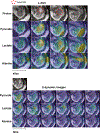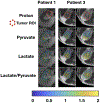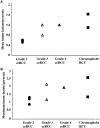Metabolic imaging with hyperpolarized 13 C pyruvate magnetic resonance imaging in patients with renal tumors-Initial experience
- PMID: 33844280
- PMCID: PMC8565774
- DOI: 10.1002/cncr.33554
Metabolic imaging with hyperpolarized 13 C pyruvate magnetic resonance imaging in patients with renal tumors-Initial experience
Abstract
Background: Optimal treatment selection for localized renal tumors is challenging because of their variable biologic behavior and limitations in the preoperative assessment of tumor aggressiveness. The authors investigated the emerging hyperpolarized (HP) 13 C magnetic resonance imaging (MRI) technique to noninvasively assess tumor lactate production, which is strongly associated with tumor aggressiveness.
Methods: Eleven patients with renal tumors underwent HP 13 C pyruvate MRI before surgical resection. Tumor 13 C pyruvate and 13 C lactate images were acquired dynamically. Five patients underwent 2 scans on the same day to assess the intrapatient reproducibility of HP 13 C pyruvate MRI. Tumor metabolic data were compared with histopathology findings.
Results: Eight patients had tumors with a sufficient metabolite signal-to-noise ratio for analysis; an insufficient tumor signal-to-noise ratio was noted in 2 patients, likely caused by poor tumor perfusion and, in 1 patient, because of technical errors. Of the 8 patients, 3 had high-grade clear cell renal cell carcinoma (ccRCC), 3 had low-grade ccRCC, and 2 had chromophobe RCC. There was a trend toward a higher lactate-to-pyruvate ratio in high-grade ccRCCs compared with low-grade ccRCCs. Both chromophobe RCCs had relatively high lactate-to-pyruvate ratios. Good reproducibility was noted across the 5 patients who underwent 2 HP 13 C pyruvate MRI scans on the same day.
Conclusions: The current results demonstrate the feasibility of HP 13 C pyruvate MRI for investigating the metabolic phenotype of localized renal tumors. The initial data indicate good reproducibility of metabolite measurements. In addition, the metabolic data indicate a trend toward differentiating low-grade and high-grade ccRCCs, the most common subtype of renal cancer.
Lay summary: Renal tumors are frequently discovered incidentally because of the increased use of medical imaging, but it is challenging to identify which aggressive tumors should be treated. A new metabolic imaging technique was applied to noninvasively predict renal tumor aggressiveness. The imaging results were compared with tumor samples taken during surgery and showed a trend toward differentiating between low-grade and high-grade clear cell renal cell carcinomas, which are the most common type of renal cancers.
Keywords: hyperpolarized 13C; lactate; magnetic resonance imaging; molecular; pyruvate; renal cell carcinoma.
© 2021 American Cancer Society.
Figures






Similar articles
-
Initial Experience of Metabolic Imaging With Hyperpolarized [1-13C]pyruvate MRI in Kidney Transplant Patients.J Magn Reson Imaging. 2025 Apr;61(4):1969-1978. doi: 10.1002/jmri.29580. Epub 2024 Sep 6. J Magn Reson Imaging. 2025. PMID: 39239784
-
Non-Invasive Assessment of Lactate Production and Compartmentalization in Renal Cell Carcinomas Using Hyperpolarized 13C Pyruvate MRI.Cancers (Basel). 2018 Sep 5;10(9):313. doi: 10.3390/cancers10090313. Cancers (Basel). 2018. PMID: 30189677 Free PMC article.
-
Modeling hyperpolarized lactate signal dynamics in cells, patient-derived tissue slice cultures and murine models.NMR Biomed. 2021 Mar;34(3):e4467. doi: 10.1002/nbm.4467. Epub 2021 Jan 7. NMR Biomed. 2021. PMID: 33415771 Free PMC article.
-
Characterization of small (<4cm) solid renal masses by computed tomography and magnetic resonance imaging: Current evidence and further development.Diagn Interv Imaging. 2018 Jul-Aug;99(7-8):443-455. doi: 10.1016/j.diii.2018.03.004. Epub 2018 Mar 30. Diagn Interv Imaging. 2018. PMID: 29606371 Review.
-
Magnetic resonance imaging as a biomarker in renal cell carcinoma.Cancer. 2009 May 15;115(10 Suppl):2334-45. doi: 10.1002/cncr.24237. Cancer. 2009. PMID: 19402070 Review.
Cited by
-
Metabolite-Specific Echo Planar Imaging for Preclinical Studies with Hyperpolarized 13C-Pyruvate MRI.Tomography. 2023 Mar 27;9(2):736-749. doi: 10.3390/tomography9020059. Tomography. 2023. PMID: 37104130 Free PMC article.
-
Mutual-information based optimal experimental design for hyperpolarized [Formula: see text]C-pyruvate MRI.Sci Rep. 2023 Oct 23;13(1):18047. doi: 10.1038/s41598-023-44958-y. Sci Rep. 2023. PMID: 37872226 Free PMC article.
-
Initial Experience of Metabolic Imaging with Hyperpolarized [1-13C]pyruvate MRI in Kidney Transplant Patients.ArXiv [Preprint]. 2024 Sep 10:arXiv:2409.06664v1. ArXiv. 2024. Update in: J Magn Reson Imaging. 2025 Apr;61(4):1969-1978. doi: 10.1002/jmri.29580. PMID: 39314508 Free PMC article. Updated. Preprint.
-
Quo Vadis Hyperpolarized 13C MRI?Z Med Phys. 2025 Feb;35(1):8-32. doi: 10.1016/j.zemedi.2023.10.004. Epub 2023 Dec 29. Z Med Phys. 2025. PMID: 38160135 Free PMC article. Review.
-
K-Means Clustering of Hyperpolarised 13C-MRI Identifies Intratumoral Perfusion/Metabolism Mismatch in Renal Cell Carcinoma as the Best Predictor of the Highest Grade.Cancers (Basel). 2025 Feb 7;17(4):569. doi: 10.3390/cancers17040569. Cancers (Basel). 2025. PMID: 40002163 Free PMC article.
References
-
- Hollingsworth JM, Miller DC, Daignault S, Hollenbeck BK. Rising incidence of small renal masses: a need to reassess treatment effect. J Natl Cancer Inst. 2006;98:1331–1334. - PubMed
-
- Campbell S, Uzzo R, Allaf ME, et al. Renal mass and localized renal cancer: AUA Guideline. J Urol. 2017;198:520–529. - PubMed
-
- Leveridge MJ, Finelli A, Kachura JR, et al. Outcomes of small renal mass needle core biopsy, nondiagnostic percutaneous biopsy, and the role of repeat biopsy. Euro Urol. 2011;60:578–584. - PubMed
Publication types
MeSH terms
Substances
Grants and funding
LinkOut - more resources
Full Text Sources
Other Literature Sources
Medical
Research Materials
Miscellaneous

